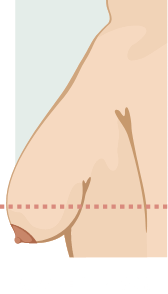Contact Us
Please check out our gallery if you wish to see breast lift before-and-after photos and contact us if you have any questions or would like to schedule a consultation.
Mastopexy is the plastic surgery procedure for lifting the breasts. Many patients come to Dr. David L. Durst—our experienced plastic surgeon in Huntsville—with the desire to have their breasts lifted to a more youthful position. When he sees you, he will discuss this procedure and explain the process in complete detail. Mastopexy is customized for each patient who has the procedure done.
Many times, Dr. Durst will see patients who are considering breast surgery, but who do not really know exactly what they need. He will talk with you and explain which technique will work best for your concerns. This often involves a careful examination and some measurements. Also, he and his staff will discuss your goals to make sure that he can outline a plan that can best suit your aesthetic ideal.
Some individuals may have mild droopiness in their breast appearance that can be treated with breast implants alone; however, most patients experience breast ptosis (sag) that requires a more comprehensive approach. The components of breast ptosis include a low positioning of the nipple and some sagging of the breast tissue. While certain women experience breast droop for genetic reasons, the loss of defined breast contours can also develop as a result of weight gain followed by weight loss. The most common reason for breast sag is related to aesthetic changes caused by pregnancy, which involve the breasts getting larger and subsequently shrinking. The skin often doesn’t contract to the breasts’ new shape, causing concern for many patients who experience volume loss and a “deflated” breast appearance after having children.
If the preceding concerns are applicable to you, a breast lift may be able to help you reach your desired aesthetic. For patients who are troubled by breast sag and additionally believe their breast size is too small, Dr. Durst often places implants in conjunction with performing a breast lift. He can also treat patients who feel their breasts appear large and heavy. In these situations, a small breast reduction combined with a lift is performed to help obtain the ideal shape.
If you notice your breasts beginning to droop but you’re unsure about surgery, getting a better understanding of the severity of your breast sag may help you decide whether mastopexy is right for you. Breast drooping, which is medically referred to as breast ptosis, is generally divided into three grades:



While this can help shed light on the extent of your breast sag, a consultation with a board-certified plastic surgeon is the best way to confirm whether your goals can be achieved with breast lift surgery or another procedure. Dr. Durst can evaluate your concerns and help you determine the most optimal treatment plan for your needs.
A breast lift is typically performed as an outpatient surgery using general anesthesia. Dr. Durst will outline the mastopexy plan with drawings on your chest prior to the surgery. Then, the incisions will be made, and the tissue will be rearranged to achieve the nipple elevation and tightening of the tissue that will create the best possible results. There are a variety of techniques that can be used to complete a breast lift procedure, and the method utilized will depend on your individual needs. Some of the techniques include:

Also referred to as a donut mastopexy, this technique can be most effective for individuals whose breasts appear asymmetrical or have an irregular nipple position. With this approach, incisions made encircling the areola are used to remove excess tissue and skin while breasts are elevated and tightened. This method can reduce the diameter of the areolas and lift the nipple position approximately 2 centimeters. This technique is typically not an ideal method for women who are breastfeeding or planning to breastfeed.
Also known as a vertical breast lift, “lollipop” mastopexies can be an effective breast lift technique for women with medium-sized breasts and moderate to severe breast droopiness, or large-sized breasts with mild breast droopiness. A lollipop-shaped incision is made around the areola and down the middle of the breast to the breast crease. Extra skin and tissue are then removed and the breasts are tightened, smoothed, and elevated. With this unique incision type, more horizontal excess skin can be removed. This approach is typically utilized when a full mastopexy is unnecessary, but there is too much skin laxity or breast sag for a periareolar mastopexy.
Full mastopexies are typically performed on individuals with moderate to severe sagginess in their breasts. This is generally indicated when the nipple and areola – the dark-pigmented area surrounding the nipple – are located below the breast crease or when the breasts point downward. In a full mastopexy, an inverted T-incision is made around the areola, down to the breast crease, and along the breast fold. Excess tissue and skin is then removed, while the remaining tissue and skin is tightened and smoothed out. The breasts are ultimately lifted to a higher, more youthful position. Women with mild breast sag can sometimes be treated effectively with a less involved lift technique, but a full mastopexy is one of the most common approaches to a breast lift.
After surgery, many patients initially think their breasts are too high and too tight. It takes several weeks for the breasts to settle and appear more natural-looking. Dr. Durst will recommend what type of bra to wear in the long term. Soreness associated with the surgery is mild to moderate and can be easily controlled by medications, which Dr. Durst will prescribe. Most patients take about a week off of work.
The results with breast lift are usually very, very dramatic in most patients. Pictures are taken at two months and again one year after surgery. Dr. Durst will recommend that you follow up with him over the years.
Any surgical operation will leave some degree of residual scarring; however, an experienced plastic surgeon is typically adept at placing incisions discreetly within the natural lines and contours of the body when possible for minimized visible scarring. In general, the extent of your breast lift scars will depend on the amount of sag that was corrected during your procedure. If you are considering a breast augmentation with implants, the same incisions for the breast lift component of surgery can often be used to insert the implants. In either case, any surgical scars will fade to some degree as time passes. Dr. Durst is very proficient performing breast lift surgery and always strives to ensure incision marks are well-concealed under a bra or bikini top.
As with any surgical procedure, there is no fixed cost of a breast lift and the price varies from patient to patient depending on their unique needs. Your personalized quote will be calculated based on a number of considerations unique to your custom-designed treatment plan, including:
In general, the cost of a mastopexy will include fees for the surgeon, anesthesia, pre- and post-operative care, and the addition of breast implants (if a breast augmentation mastopexy is being pursued) as well as other operational expenses. The geographic location where the procedure is performed and the expertise of your plastic surgeon will also influence your total cost estimate. Fortunately, cosmetic enhancement in Alabama is generally more affordable when compared to coastal states. With all this in mind, the average cost of a breast lift with the addition of implants generally falls between $7,800 and $10,850. The price of breast lift surgery as a lone procedure depends on the degree of “lift” necessary to achieve your goals, and our team will appraise you once your needs are known.
Dr. Durst will be sure to perform a thorough evaluation of your needs during a consultation and provide a complete breakdown of the costs associated with your surgery. Our team will then go over our accepted modes of payment as well as your financing options. We understand the need to bring the cost of surgery into your budget and we work with some of the leading plastic surgery financing companies in the nation to help you pay for your treatment over time. Options like CareCredit® and Prosper® Healthcare Lending offer a number of flexible low- to no-interest payment plans with affordable monthly installments for qualified applicants. If you have any questions or concerns regarding the price of a breast lift, please don’t hesitate to contact our office today.
A breast lift can typically last well into the future, but the exact lifespan of the results ultimately depends on your age, genetics, and lifestyle habits. While the effects of gravity and the natural aging process will continue, there are a number of simple measures patients can take to prolong the outcome of surgery. Skin laxity is often a key reason for recurrent breast sag; therefore, taking good care of the skin on the chest by applying sunscreen daily can help improve skin elasticity and slow the aging process. Weight fluctuation also plays a major role in breast ptosis, making it important to maintain a stable weight after surgery in order to minimize repeated stretching of the skin. Generally speaking, a breast lift is designed to be very long-lasting, and patients often enjoy their new breast contours for many years to come.
Breastfeeding after breast lift surgery is certainly possible and, if desired, Dr. Durst can perform the procedure to preserve the nerves and milk ducts that allow lactation. With that said, it’s important to note that not all women have the ability to breastfeed to begin with; therefore, patients unable to nurse before surgery will not see a change in lactating function after the procedure. In any case, we recommend postponing your breast lift until after all plans for breastfeeding are complete. It is often the case that the volume loss and skin laxity resulting from pregnancy and nursing reverses the rejuvenation achieved with a breast lift, creating the same concerns that were initially treated with surgery. The most important thing to remember with regard to breastfeeding after a breast lift is to always discuss any future plans for nursing with Dr. Durst so he can appropriately tailor the surgery to your needs.
A surgical breast lift remains the only effective technique to rejuvenate the positioning of the breasts and improve the look of sag. Although some exercises purport to naturally lift the breasts, these efforts merely tone the pectoral muscles and fail to address the volume loss, as well as the skin and breast tissue laxity, that causes breast ptosis. There is currently no non-surgical treatment that can effectively raise and reshape the breasts with the same quality of results as a breast lift.
For complete rejuvenation of the breast aesthetic, many patients opt to undergo a breast lift and breast augmentation procedure simultaneously. This popular combination surgery, also known as a breast lift with implants or breast augmentation mastopexy, is designed to enhance breast volume and fullness while lifting the breasts to a more youthful positioning. This comprehensive approach typically allows an improved breast shape and overall contour as well as a minimized appearance of sag. A breast lift with implants is usually a very popular option for women who have undergone pregnancy or breastfeeding, or those who have lost breast volume and/or projection as a result of the natural aging process. Generally speaking, the surgery can yield the benefits of both procedures in a single operation for improved breast volume, projection, firmness, symmetry, and shape.
Mastopexy is a cosmetic procedure, therefore insurance companies typically do not consider the surgery medically necessary. Consequently, a breast lift is not covered by medical insurance. However, our team believes surgery should be accessible to anyone who wants to improve their confidence, which is why we work with third-party financing companies like CareCredit® and Prosper® Healthcare Lending to give qualified individuals a more affordable way to pay for their breast lift.
After surgery, it’s not uncommon to experience numbness or changes in nipple sensation during the recovery period. That said, some women do not experience any differences in sensation at all — this varies from patient to patient and also depends on whether the nipples were resized/repositioned. Dr. Durst can discuss the procedure with you so you have a better idea of what to expect after mastopexy.
A breast lift is performed under general anesthesia, so patients will be sedated during surgery. Following the procedure, patients typically report feelings of soreness and weakness rather than pain. The recovery period after mastopexy is generally described as very tolerable and over-the-counter pain medications are usually enough to manage any discomfort until these effects subside naturally.
Swelling will naturally subside after breast lift surgery, but there are a few measures that can be taken during the healing process to further reduce inflammation. After surgery, we recommend wearing compression garments for the amount of time prescribed by Dr. Durst, as these wrappings can help promote blood flow and accelerate healing. Eating a healthy diet rich in antioxidants, zinc, and other nutrients can also help reduce post-operative swelling. We recommend closely following Dr. Durst’s aftercare instructions to encourage the best possible recovery.
Please check out our gallery if you wish to see breast lift before-and-after photos and contact us if you have any questions or would like to schedule a consultation.